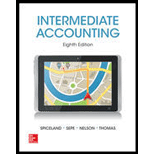
Concept explainers
(1)
Trade discount:
A trade discount is the reduction in price allowed by the manufacturer to the wholesalers when the products are purchased in large quantity.
Cash discount:
A cash discount is the reduction in the amount that is to be paid by the credit customers. It is usually allowed by the seller to buyer or customer, in order to motivate the customer to pay within a specified period of time. A cash discount is often referred as sales discount.
To prepare: The
(1)
Answer to Problem 7.5E
- Sales Entry:
Compute the sales revenue:
Working notes:
Compute the list price of sales:
Record the journal entry:
| Date | Account Title and Explanation |
Post Ref. |
Debit ($) |
Credit ($) |
| November 17, 2016 | 42,000 | |||
| Sales Revenue | 42,000 | |||
| (To record the sales on account) |
Table (1)
- Collection Entry:
| Date | Account Title and Explanation |
Post Ref. |
Debit ($) |
Credit ($) |
| November 26, 2016 | Cash (3) | 41,160 | ||
| Sales Discount (2) | 840 | |||
| Accounts Receivable | 42,000 | |||
| (To record the sales remittance) |
Table (2)
Explanation of Solution
The sale was made on November 17 and the payment is received on November 26 Hence, the customer is eligible for a sales discount of 2% (2/10 term).
Working note:
Compute the amount of discount:
Compute the amount of cash received from the customer:
(2)
To prepare: The journal entry to record the sales and collection assuming the payment was received on December 15, 2016.
(2)
Answer to Problem 7.5E
The journal entry to record the sales and collection assuming the payment was received on December 15, 2016 is prepared as follows:
- Sales Entry:
| Date | Account Title and Explanation |
Post Ref. |
Debit ($) |
Credit ($) |
| November 17, 2016 | Accounts Receivable | 42,000 | ||
| Sales Revenue | 42,000 | |||
| (To record the sales on account) |
Table (3)
- Collection Entry:
| Date | Account Title and Explanation |
Post Ref. |
Debit ($) |
Credit ($) |
| December 15, 2016 | Cash | 42,000 | ||
| Accounts Receivable | 42,000 | |||
| (To record the sales remittance) |
Table (4)
Explanation of Solution
The sale was made on November 17 and the payment is received on December 15. Hence, the customer is not eligible for any sales discount. He has to pay the full amount.
(3) Requirement 1
To prepare: The journal entry to record the sales and collection on November 17, 2016 using net method.
(3) Requirement 1
Answer to Problem 7.5E
- Sales Entry:
| Date | Account Title and Explanation |
Post Ref. |
Debit ($) |
Credit ($) |
| November 17, 2016 | Accounts Receivable | 41,160 | ||
| Sales Revenue | 41,160 | |||
| (To record the sales on account) |
Table (5)
- Collection Entry:
| Date | Account Title and Explanation |
Post Ref. |
Debit ($) |
Credit ($) |
| November 26, 2016 | Cash | 41,160 | ||
| Accounts Receivable | 41,160 | |||
| (To record the sales remittance) |
Table (6)
Explanation of Solution
The sale was made on November 17 and the payment is received on November 26. Hence, the customer is eligible for a sales discount of 2% (2/10 term).
(3) Requirement 2
To prepare: The journal entry to record the sales and collection assuming the payment was received on December 15, 2016, using net method.
(3) Requirement 2
Answer to Problem 7.5E
- Sales Entry:
| Date | Account Title and Explanation |
Post Ref. |
Debit ($) |
Credit ($) |
| November 17, 2016 | Accounts Receivable | 41,160 | ||
| Sales Revenue | 41,160 | |||
| (To record the sales on account) |
Table (7)
- Collection Entry:
| Date | Account Title and Explanation |
Post Ref. |
Debit ($) |
Credit ($) |
| December 15, 2016 | Cash | 42,000 | ||
| Accounts Receivable | 41,160 | |||
| Interest Revenue | 840 | |||
| (To record the sales remittance) |
Table (8)
Explanation of Solution
The sale was made on November 17 and the payment is received on December 15. Hence, the customer is eligible for a sales discount of 2% (2/10 term). But he has to pay the interest for the same.
Want to see more full solutions like this?
Chapter 7 Solutions
Intermediate Accounting w/ Annual Report; Connect Access Card
- Please provide the solution to this financial accounting question using proper accounting principles.arrow_forwardI need help finding the accurate solution to this financial accounting problem with valid methods.arrow_forwardCan you explain this financial accounting question using accurate calculation methods?arrow_forward
- I am looking for help with this financial accounting question using proper accounting standards.arrow_forwardPlease provide the correct answer to this financial accounting problem using accurate calculations.arrow_forwardCan you solve this financial accounting problem with appropriate steps and explanations?arrow_forward

 AccountingAccountingISBN:9781337272094Author:WARREN, Carl S., Reeve, James M., Duchac, Jonathan E.Publisher:Cengage Learning,
AccountingAccountingISBN:9781337272094Author:WARREN, Carl S., Reeve, James M., Duchac, Jonathan E.Publisher:Cengage Learning, Accounting Information SystemsAccountingISBN:9781337619202Author:Hall, James A.Publisher:Cengage Learning,
Accounting Information SystemsAccountingISBN:9781337619202Author:Hall, James A.Publisher:Cengage Learning, Horngren's Cost Accounting: A Managerial Emphasis...AccountingISBN:9780134475585Author:Srikant M. Datar, Madhav V. RajanPublisher:PEARSON
Horngren's Cost Accounting: A Managerial Emphasis...AccountingISBN:9780134475585Author:Srikant M. Datar, Madhav V. RajanPublisher:PEARSON Intermediate AccountingAccountingISBN:9781259722660Author:J. David Spiceland, Mark W. Nelson, Wayne M ThomasPublisher:McGraw-Hill Education
Intermediate AccountingAccountingISBN:9781259722660Author:J. David Spiceland, Mark W. Nelson, Wayne M ThomasPublisher:McGraw-Hill Education Financial and Managerial AccountingAccountingISBN:9781259726705Author:John J Wild, Ken W. Shaw, Barbara Chiappetta Fundamental Accounting PrinciplesPublisher:McGraw-Hill Education
Financial and Managerial AccountingAccountingISBN:9781259726705Author:John J Wild, Ken W. Shaw, Barbara Chiappetta Fundamental Accounting PrinciplesPublisher:McGraw-Hill Education





